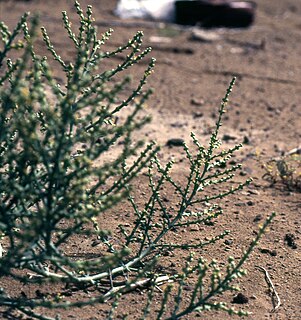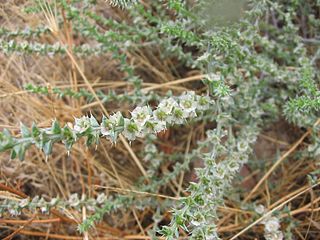
Amaranthaceae is a family of flowering plants commonly known as the amaranth family, in reference to its type genus Amaranthus. It includes the former goosefoot family Chenopodiaceae and contains about 165 genera and 2,040 species, making it the most species-rich lineage within its parent order, Caryophyllales.

The Salsoloideae are a subfamily of the Amaranthaceae, formerly in family Chenopodiaceae.

Kali turgidum, commonly known as prickly saltwort or prickly glasswort, is an annual plant that grows in salty sandy coastal soils.

Salsola is a genus of the subfamily Salsoloideae in the family Amaranthaceae. The genus sensu stricto is distributed in central and southwestern Asia, North Africa, and the Mediterranean. A common name of various members of this genus and related genera is saltwort, for their salt tolerance. The genus name Salsola is from the Latin salsus, meaning "salty".
Kali paulsenii is a species of flowering plant in the amaranth family known by the common name barbwire Russian thistle. It is native to Eurasia and it is present in the American southwest as an introduced species and sometimes a weed in sandy, disturbed habitat types. It is an annual herb forming a brambly clump of intricately branched, prostrate to erect stems growing up to a meter long. The reddish stems are lined with yellow-green, thready, fleshy, or needlelike, spine-tipped leaves a few millimeters to three centimeters long. The inflorescence is an interrupted series of flowers, with one flower per leaf axil. The flower is surrounded by a disclike array of wide, winged sepals which are whitish at the tips and pinkish at the bases.

Seidlitzia stocksii is a shrub species of the family Amaranthaceae.

The Suaedoideae are a subfamily of plants in the family Amaranthaceae.
Salsola kali was the botanical name for a species of flowering plants in the amaranth family, whose subspecies have been recently reclassified as two separate species in the genus Kali:

Kali is a genus of plants in the subfamily Salsoloideae in the family Amaranthaceae. Common names of various members of this genus include tumbleweed for its wind-blown seed dispersal habit, and Tartar thistle and Russian thistle for its origins.

Anabasis is a genus of plants in the subfamily Salsoloideae of the family Amaranthaceae. It is distributed in southern Europe, North Africa, and Asia.
Vladimir Ivanovich Pyankov was a Russian phytophysiologist, professor of the Ural State University.
Salsola imbricata is a small species of shrub in the family Amaranthaceae. It grows in deserts and arid regions of north Africa, the Arabian Peninsula and southwestern Asia.

Salsola vermiculata, commonly known as Mediterranean saltwort, is a perennial plant in the family Amaranthaceae. It is native to arid and semi-arid regions of the Middle East, North Africa and southern Europe where it is used as a fodder plant for livestock.

Caroxylon is a genus of shrubby flowering plants in the family Chenopodiaceae, found in drier areas of the Old World, including southern Africa, Madagascar, northern Africa, Mediterranean islands of Europe, the Canary Islands, Socotra, Ukraine, Russia, western Asia, Central Asia, India, western and northern China, and Mongolia.

Anemonastrum is a genus of flowering plants in the buttercup family Ranunculaceae. Plants of the genus are native to the temperate and subarctic regions of North America, Greenland, Europe, Asia, South America, and New Zealand. The generic name Anemonastrum means "somewhat like anemone", a reference to the Anemone genus of closely related plants. It chiefly differs from Anemone in having a base chromosome number of x=7, as opposed to x=8.
Xylosalsola is a genus of flowering plants belonging to the family Amaranthaceae.
Amalophyllon is a genus of flowering plants belonging to the family Gesneriaceae.
Kaviria is a genus of flowering plants belonging to the family Amaranthaceae.
Nomopyle is a genus of flowering plants belonging to the family Gesneriaceae.
Sibbaldianthe is a genus of flowering plants belonging to the family Rosaceae.










